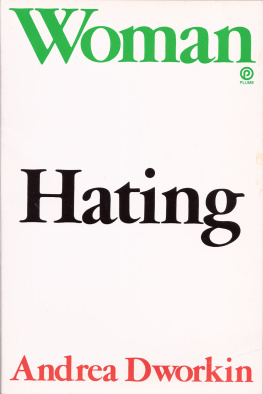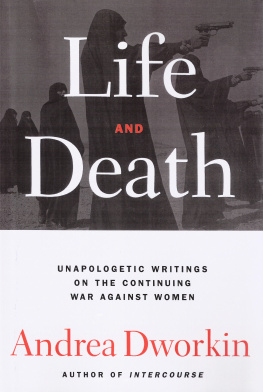Andrea Dworkin - Woman Hating
Here you can read online Andrea Dworkin - Woman Hating full text of the book (entire story) in english for free. Download pdf and epub, get meaning, cover and reviews about this ebook. year: 1991, publisher: Plume, genre: Romance novel. Description of the work, (preface) as well as reviews are available. Best literature library LitArk.com created for fans of good reading and offers a wide selection of genres:
Romance novel
Science fiction
Adventure
Detective
Science
History
Home and family
Prose
Art
Politics
Computer
Non-fiction
Religion
Business
Children
Humor
Choose a favorite category and find really read worthwhile books. Enjoy immersion in the world of imagination, feel the emotions of the characters or learn something new for yourself, make an fascinating discovery.
- Book:Woman Hating
- Author:
- Publisher:Plume
- Genre:
- Year:1991
- Rating:3 / 5
- Favourites:Add to favourites
- Your mark:
- 60
- 1
- 2
- 3
- 4
- 5
Woman Hating: summary, description and annotation
We offer to read an annotation, description, summary or preface (depends on what the author of the book "Woman Hating" wrote himself). If you haven't found the necessary information about the book — write in the comments, we will try to find it.
Woman Hating — read online for free the complete book (whole text) full work
Below is the text of the book, divided by pages. System saving the place of the last page read, allows you to conveniently read the book "Woman Hating" online for free, without having to search again every time where you left off. Put a bookmark, and you can go to the page where you finished reading at any time.
Font size:
Interval:
Bookmark:
INTRODUCTION
This book is an action, a political action where revolution is the goal. It has no other purpose. It is not cerebral wisdom, or academic horseshit, or ideas carved in granite or destined for immortality. It is part of a process and its context is change. It is part of a planetary movement to restructure community forms and human consciousness so that people have power over their own lives, participate fully in community, live in dignity and freedom.
The commitment to ending male dominance as the fundamental psychological, political, and cultural reality of earth-lived life is the fundamental revolutionary commitment. It is a commitment to transformation of the self and transformation of the social reality on every level. The core of this book is an analysis of sexism (that system of male dominance), what it is, how it operates on us and in us. However, I do want to discuss briefly two problems, tangential to that analysis, but still crucial to the development of revolutionary program and consciousness. The first is the nature of the womens movement as such, and the second has to do with the work of the writer.
Until the appearance of the brilliant anthology Sisterhood Is Powerful and Kate Milletts extraordinary book Sexual Politics , women did not think of themselves as oppressed people. Most women, it must be admitted, still do not. But the womens movement as a radical liberation movement in Amerika can be dated from the appearance of those two books. We learn as we reclaim our herstory that there was a feminist movement which organized around the attainment of the vote for women. We learn that those feminists were also ardent abolitionists. Women came out as abolitionists out of the closets, kitchens, and bedrooms; into public meetings, newspapers, and the streets. Two activist heroes of the abolitionist movement were Black women, Sojourner Truth and Harriet Tubman, and they stand as prototypal revolutionary models.
Those early Amerikan feminists thought that suffrage was the key to participation in Amerikan democracy and that, free and enfranchised, the former slaves would in fact be free and enfranchised. Those women did not imagine that the vote would be effectively denied Blacks through literacy tests, property qualifications, and vigilante police action by white racists. Nor did they imagine the separate but equal doctrine and the uses to which it would be put.
Feminism and the struggle for Black liberation were parts of a compelling whole. That whole was called, ingenuously perhaps, the struggle for human rights. The fact is that consciousness, once experienced, cannot be denied. Once women experienced themselves as activists and began to understand the reality and meaning of oppression, they began to articulate a politically conscious feminism. Their focus, their concrete objective, was to attain suffrage for women.
The womens movement formalized itself in 1848 at Seneca Falls when Elizabeth Cady Stanton and Lucretia Mott, both activist abolitionists, called a convention. That convention drafted The Seneca Falls Declaration of Rights and Sentiments which is to this day an outstanding feminist declaration.
In struggling for the vote, women developed many of the tactics which were used, almost a century later, in the Civil Rights Movement. In order to change laws, women had to violate them. In order to change convention, women had to violate it. The feminists (suffragettes) were militant political activists who used the tactics of civil disobedience to achieve their goals.
The struggle for the vote began officially with the Seneca Falls Convention in 1848. It was not until August 26, 1920, that women were given the vote by the kindly male electorate. Women did not imagine that the vote would scarcely touch on, let alone transform, their own oppressive situations. Nor did they imagine that the separate but equal doctrine would develop as a tool of male dominance. Nor did they imagine the uses to which it would be put.
There have also been, always, individual feminists women who violated the strictures of the female role, who challenged male supremacy, who fought for the right to work, or sexual freedom, or release from the bondage of the marriage contract. Those individuals were often eloquent when they spoke of the oppression they suffered as women in their own lives, but other women, properly trained to their roles, did not listen. Feminists, most often as individuals but sometimes in small militant groups, fought the system which oppressed them, analyzed it, were jailed, were ostracized, but there was no general recognition among women that they were oppressed.
In the last 5 or 6 years, that recognition has become more widespread among women. We have begun to understand the extraordinary violence that has been done to us, that is being done to us: how our minds are aborted in their development by sexist education; how our bodies are violated by oppressive grooming imperatives; how the police function against us in cases of rape and assault; how the media, schools, and churches conspire to deny us dignity and freedom; how the nuclear family and ritualized sexual behavior imprison us in roles and forms which are degrading to us. We developed consciousness-raising sessions to try to fathom the extraordinary extent of our despair, to try to search out the depth and boundaries of our internalized anger, to try to find strategies for freeing ourselves from oppressive relationships, from masochism and passivity, from our own lack of self-respect. There was both pain and ecstasy in this process. Women discovered each other, for truly no oppressed group had ever been so divided and conquered. Women began to deal with concrete oppressions: to become part of the economic process, to erase discriminatory laws, to gain control over our own lives and over our own bodies, to develop the concrete ability to survive on our own terms. Women also began to articulate structural analyses of sexist society Millett did that with Sexual Politics; in Vaginal Politics Ellen Frankfort demonstrated the complex and deadly antiwoman biases of the medical establishment; in Women and Madness Dr. Phyllis Chesler showed that mental institutions are prisons for women who rebel against societys well-defined female role.
We began to see ourselves clearly, and what we saw was dreadful. We saw that we were, as Yoko Ono wrote, the niggers of the world, slaves to the slave. We saw that we were the ultimate house niggers, ass-licking, bowing, scraping, shuffling fools. We recognized all of our social behavior as learned behavior that functioned for survival in a sexist world: we painted ourselves, smiled, exposed legs and ass, had children, kept house, as our accommodations to the reality of power politics.
Most of the women involved in articulating the oppression of women were white and middle class. We spent, even if we did not earn or control, enormous sums of money. Because of our participation in the middle-class lifestyle we were the oppressors of other people, our poor white sisters, our Black sisters, our Chicana sisters and the men who in turn oppressed them. This closely interwoven fabric of oppression, which is the racist class structure of Amerika today, assured that wherever one stood, it was with at least one foot heavy on the belly of another human being.
As white, middle-class women, we lived in the house of the oppressor-of-us-all who supported us as he abused us, dressed us as he exploited us, treasured us in payment for the many functions we performed. We were the best-fed, best-kept, best-dressed, most willing concubines the world has ever known. We had no dignity and no real freedom, but we did have good health and long lives.
The womens movement has not dealt with this bread-and-butter issue, and that is its most awful failure. There has been little recognition that the destruction of the middle-class lifestyle is crucial to the development of decent community forms in which all people can be free and have dignity. There is certainly no program to deal with the realities of the class system in Amerika. On the contrary, most of the womens movement has, with appalling blindness, refused to take that kind of responsibility. Only the day-care movement has in any way reflected, or acted pragmatically on, the concrete needs of all classes of women. The anger at the Nixon administration for cutting day-care funds is naive at best. Given the structure of power politics and capital in Amerika, it is ridiculous to expect the federal government to act in the interests of the people. The money available to middle-class women who identify as feminists must be channeled into the programs we want to develop, and we must develop them. In general, middle-class women have absolutely refused to take any action, make any commitment which would interfere with, threaten, or significantly alter a lifestyle, a living standard, which is moneyed and privileged.
Next pageFont size:
Interval:
Bookmark:
Similar books «Woman Hating»
Look at similar books to Woman Hating. We have selected literature similar in name and meaning in the hope of providing readers with more options to find new, interesting, not yet read works.
Discussion, reviews of the book Woman Hating and just readers' own opinions. Leave your comments, write what you think about the work, its meaning or the main characters. Specify what exactly you liked and what you didn't like, and why you think so.






